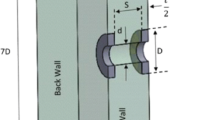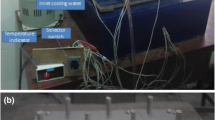Abstract
The steady-state natural convection heat transfer from aluminum vertical rectangular fins extending perpendicularly from vertical rectangular base was investigated experimentally. Thirty different fin configurations were tested. Experiments were performed for fin lengths of 250 and 340 mm. Fin thickness was kept fixed at 3 mm. Fin height and fin spacing were varied from 5 to 25 mm and 5.75 to 85.5 mm, respectively. Five heat inputs ranging from 25 to 125 W were supplied for all fin configurations, hence; the base-to-ambient temperature differences were measured in order to evaluate the heat transfer rates from fin arrays. The results of experiments have shown that the convective heat transfer rate from fin arrays depends on geometric parameters and base-to-ambient temperature difference. The separate roles of fin height, fin spacing and base-to-ambient temperature difference were investigated. It was found that, for a given base-to-ambient temperature difference, the convective heat transfer rate from fin arrays takes on a maximum value as a function of fin spacing and fin height and an optimum fin spacing value which maximizes the convective heat transfer rate from the fin array is available for every fin height. These measurements were to extend data obtained earlier from aluminum fin-arrays using the same experimental system and method (Yüncü and Güvenç in Heat Mass Transfer 37:409–416, 2001). Data collated from earlier and present work cover the range of fin spacing from 4.5 to 85.5 mm. The fin length range was from 100 to 340 mm, the fin height from 5 to 25 mm and the number of fins per array 3 to 34. The range of base-to-ambient temperature difference was quite extensive, from 30 to 150 K. These results indicate that the optimum fin spacing is between 6.1 and 11.9 mm, for the fin arrays employed in the earlier and present work. A scale analysis is performed in order to estimate the order-of-magnitude of optimum fin spacing at a given fin length and base-to-ambient temperature difference. From the scale analysis, correlations to evaluate the optimum fin spacing value and the corresponding maximum convective heat transfer rate at a given fin length and base-to-ambient temperature difference were obtained.





















Similar content being viewed by others
Abbreviations
- A :
-
area (m2)
- C p :
-
specific heat at constant pressure [kJ/(kg K)]
- g :
-
gravitational acceleration (m/s2)
- h :
-
convection heat transfer coefficient [W/(m2 K)]
- H :
-
fin height (m)
- k :
-
thermal conductivity [W/(m K)]
- L :
-
fin length (m)
- \({\dot{m}}\) :
-
mass flow rate (kg/s)
- n :
-
number of fins
- Nu :
-
Nusselt number
- Pr :
-
Prandtl number
- \({\dot{Q}}\) :
-
power input to the heater (W)
- \({\dot{Q}_{{\rm out}}}\) :
-
total heat transfer rate (W)
- \({\dot{Q}_{\rm c}}\) :
-
convection heat transfer rate (W)
- \({\dot{Q}^{{(1)}}_{\rm c}}\) :
-
convection heat transfer rate from fins in small-s limit (W)
- \({\dot{Q}^{{(2)}}_{\rm c}}\) :
-
convection heat transfer rate from fins in large-s limit (W)
- \({\dot{Q}_{0}}\) :
-
total heat transfer rate from vertical plate (W)
- Ra :
-
Rayleigh number
- s :
-
fin spacing (m)
- t :
-
fin thickness (m)
- T a :
-
ambient temperature (K)
- T f :
-
film temperature (K)
- T w :
-
base plate temperature (K)
- W :
-
base plate width (m)
- α:
-
thermal diffusivity (m2/s)
- β:
-
volumetric thermal expansion coefficient (1/K)
- ν:
-
kinematic viscosity (m2/s)
- σ:
-
Stefan–Boltzmann constant [W/(m2 K4)]
- ΔT :
-
base-to-ambient temperature difference (K)
References
Yüncü H, Güvenç A (2001) An experimental investigation on performance of rectangular fins on a vertical base in free convection heat transfer. Heat Mass Transfer 37:409–416
Starner KE, McManus HN (1963) An experimental investigation of free convection heat transfer from rectangular fin arrays. J Heat Transfer 85:273–278
Welling JR, Wooldridge CN (1965) Free convection heat transfer coefficients from vertical fins. J Heat Transfer 87:439–444
Harahap F, McManus HN (1967) Natural convection heat transfer from horizontal rectangular fin arrays. J Heat Transfer 89:32–38
Jones CD, Sparrow Smith LF (1970) Optimum arrangement of rectangular fins on horizontal surfaces for free convection heat transfer. J Heat Transfer 92:6–10
Leung CW et al (1985) Heat exchanger: optimal separation for vertical rectangular fins protruding from a vertical rectangular base. Appl Energy 19:77–85
Yüncü H, Anbar G (1998) An experimental investigation on performance of rectangular fins on a horizontal base in free convection heat transfer. Heat Mass Transfer 33:507–514
Yüncü H, Yildiz Ş (2004) An experimental investigation on performance of annular fins on a horizontal cylinder in free convection heat transfer. Heat and Mass Transfer 40:239-251
Siegel R, Howell JR (1972) Thermal radiation heat transfer. McGraw-Hill, Tokyo
Bejan A (1984) Convective heat transfer. John Wiley & Sons, New York
Incropera FP, Dewit DP (1985) Fundamentals of heat and mass transfer. John Wiley & Sons, New York
Rammohan Rao V, Venkateshan SP (1995) Experimental study of free convection in horizontal fin arrays. Int J Heat Mass Transfer 39(4):779–789
Author information
Authors and Affiliations
Corresponding author
Additional information
An erratum to this article can be found at http://dx.doi.org/10.1007/s00231-007-0329-5
Rights and permissions
About this article
Cite this article
Yazicioğlu, B., Yüncü, H. Optimum fin spacing of rectangular fins on a vertical base in free convection heat transfer. Heat Mass Transfer 44, 11–21 (2007). https://doi.org/10.1007/s00231-006-0207-6
Received:
Accepted:
Published:
Issue Date:
DOI: https://doi.org/10.1007/s00231-006-0207-6




